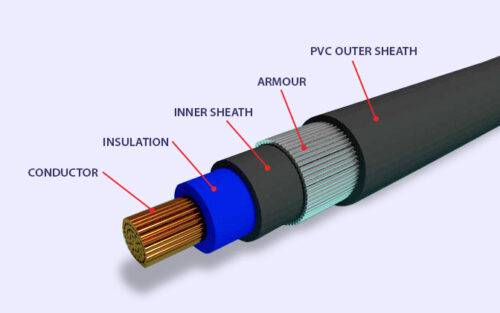

Electric power is distributed and used at the utility levels with the help of transmission systems, cables or other smaller conductors. Various type of electric cables is designed for specific requirements. The main aim of every type of electric cable is to conduct electricity or signals to the desired location. Cables and conductors have many applications such as transmission of electric power, communication and data transmission networks, earthing and safety connections etc. For example, power cables are mainly used for power transmission and distribution purposes. A power cable is constructed with one or more individually insulated electrical conductors, usually held together with an overall sheath. Cables can be classified into various categories based on different parameters like their applications, the materials used to make them, the nature of the cable, their current carrying capacity etc. Now let us discuss the different types of cables and conductors we use for various electrical applications.
Different type of electric cables is made with different properties to suit their applications. There are Armoured and Unarmoured cables.
Armoured cable has an extra layer to ensure protection from mechanically being cut or abraded. The outer layer made of plastic protects from rodents, abrasions and twists. The armouring material used is mainly steel, aluminium strip or round solid wire. It aims to protect the armoured cable from being stretched during installation. Unarmoured cables are for normal applications which does not need much mechanical strength.
For harsh conditions and applications such as High Tension (HT) transmission lines that need more mechanical strength and protection – armoured cables are used underground.
For mining, we use Armoured cables with extra mechanical strength. Wind power plants generally require flexible and UV protected cables, so cables with mechanical hard sheath are used in such cases. Flexible cables are for portable devices and tools.
There are Uninsulated and Insulated conductors which are used for particular electrical applications. Uninsulated or bare conductors are for earthing purposes and transmission lines. Bare conductors have enhanced current carrying capacity therefore they are used for efficient power transmission. In earthing applications, bare conductors help to maximize the leakage current carrying capacity, thus providing an effective earthing connection. Insulated cables are used in current-carrying applications as the insulation provides safety and protection from electric shock. Insulated conductors are of two types based on the insulation material: Thermoplastic Insulation and Thermosetting Insulation. Polyvinyl Chloride (PVC), Polyolefins, Linear Polyethene (PE), and Polyurethane (PU) come under Thermoplastic, and Ethylene Propylene (EPR), Crosslinked Polyethylene (XLPE), Ethyl Vinyl Acetate (EVA), Silicone, Neoprene, Natural rubber etc. come under Thermosetting Insulation.
Two other types of cables are single-stranded core and multi-stranded core. The multi-stranded core cable is made of multiple thin strands of wires that form together one conductor. The stranded design offers good flexibility hence they are suitable for applications where wires need to be bent or twisted. Single-stranded core cable is made of a single solid core with plastic insulation. It is difficult to bend or twist due to its stiffness, as bending might damage and break the conductor inside. They are used in places where no movement or bending is required.
We have seen that cables are used for various electrical power applications. The voltage range for power cables is defined below.
Always select the right cable considering the requirements and the characteristics of the cable to avoid electrical emergencies and other power or data losses. You can view our wide range of Cable Glands here. Feel free to contact us if you want a quotation or have any further questions regarding our Cable Management System.
Thank you for reading the blog, Axis is a leading manufacturer and supplier of Electrical Components to over 80+ Countries. Talk to our industry expert by visiting our contact us section. You can also watch our videos by our experts – click here.
Can you make four tap connections using only one connector? The Satellite Connector, also known…
In this blog, you will learn how to install Termination Kit for medium-voltage cables. What…
In 2023 India lost 15% of its generated electricity to technical and commercial losses. Power…
In this blog, you will learn how to install Insulation Piercing Connectors on MV Covered…
In this blog, you will learn how to install a Preformed Alignment Tie for Covered…
Do you know why power lines work even when they are installed at a significant…